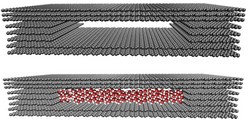2D materials and van der Waals heterostructure capillaries
A plethora of exciting opportunities appears when 2D crystals are combined in one vertical stack. Held together by the same van der Waals forces that hold together layered materials, such heterostructures offer a greater number of combinations than any traditional growth method. More importantly, the extended range of functionalities of such heterostructures yields a broad range of possible applications. To date, graphene transistors with the highest mobility are achieved by encapsulating graphene with hexagonal boron nitride. The EU-funded project 2D-HETEROSTRUCTURES (Graphene heterostructures by self-assembly: Top-down meets bottom-up) focused on the problem of mixing and matching crystals with different properties. Researchers took the most widely used technique for composing 2D heterostructures a step beyond. The technique involving transfer of large-area graphene crystals was further developed to fabricate 2D heterostructure-based capillaries. Comprising several hundreds of parallel channels, these capillaries were used to study molecular transport phenomena. Specifically, researchers looked into water transport through the channels ranging in height from a single atomic layer to many dozens of them. The fabricated nanocapillaries proved ideal for studying water confinement due to the hydrophobicity of graphene walls. Besides the interesting science, the 2D-HETEROSTRUCTURES technique opens up exciting prospects for scaling up the fabricated devices from micron sizes to those required for industrial uses. In addition, it offers the possibility to choose between different materials for the top and bottom layers of the capillary, instead of graphene.







